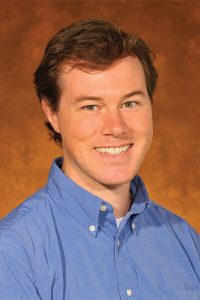MABE Faculty Worked on R&D 100 Award Winning Projects

The 2015 R&D 100 Award winners were recently announced and Associate Professor Chad Duty and Assistant Professor Brett Compton—two of the newest faculty members in the Department of Mechanical, Aerospace, and Biomedical Engineering—worked on two of the award-winning projects. The R&D 100 Awards, sponsored by R&D Magazine, are given out each year to recognize advances in the most innovative technologies that will have an impact on everyday lives and acknowledges the scientists and engineers who lead those efforts.
Duty led the Big Area Additive Manufacturing-Cincinnati (BAAM-CI) project that earned the top technology product of the year and the R&D Magazine’s 2015 Editor’s Choice Award in the process/prototyping category.
BAAM-CI is a radically new platform for additive manufacturing of polymer and composite structures. The BAAM-CI system enables components of arbitrary geometry to be 3D printed at a scale that is 10 times larger than any other commercial system and at speeds 200 to 500 times faster than existing additive machines. BAAM-CI makes the 3D printing of large structures much cheaper, faster, and better than ever before.

“The BAAM-CI system developed at Oak Ridge National Laboratory’s (ORNL) Manufacturing Demonstration Facility (MDF) represents a major advancement in the size, speed, and reduced cost of 3D Printing. BAAM-CI is a great example of innovative design, advanced materials, and systems development by a diverse group of researchers in close collaboration with a strategic industrial partner, Cincinnati Incorporated, to introduce a revolutionary manufacturing technique. In my current role within the MABE Department, I am continuing to work with the MDF to develop compositions and processing conditions for printing high performance composite materials,” Duty said.
Both Duty and Compton were part of the team that led ORNL support of the GENOA 3D Printing Simulation Software, which won an award in the software/services category. The team was led by ORNL’s Vlastimil Kunc.
ORNL collaborated with Alpha STAR Corporation (ASC) to create a 3-D printing simulation platform using GENOA software to accurately predict the printability of a generic 3D component with a focus on deflection, residual stress, damage initiation, and crack growth formation observed during the printing process. Using the software, Duty and Compton helped develop a thermo-mechanical simulation of the BAAM deposition process to determine which geometries were most likely to warp and distort under given process conditions. The software was demonstrated for various build geometries and deposition conditions for 3D printing of an automobile.
“Being able to predict which geometry is likely to distort or crack due to thermally-induced stresses is critical in designing components for 3D printing. The GENOA software package developed by Alpha STAR and ORNL not only considers part geometry, but can also account for the anisotropic material properties associated with shear-alignment of reinforcing fibers in the polymer matrix during deposition. As we develop the capacity for making larger and larger parts, the expense and time associated with a ‘trial-and-error’ approach to successful 3D printing is significant. The GENOA software is able to provide design guidance and identify potential problems before they occur,” Duty said.
Duty and Compton worked for ORNL before joining the MABE faculty in August 2015.
A complete list of the 2015 R&D Award winners can be found at rd100awards.com/2015-rd-100-award-winners.